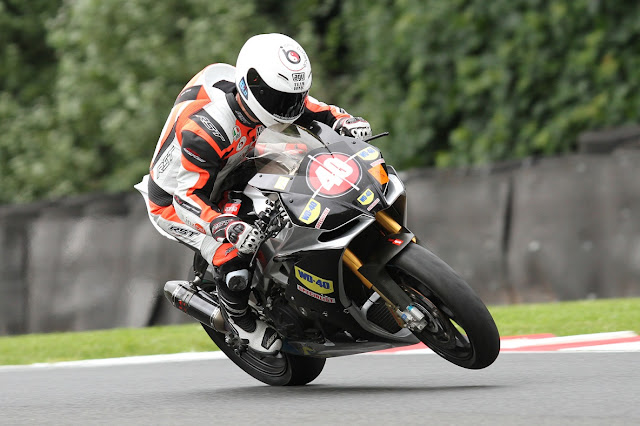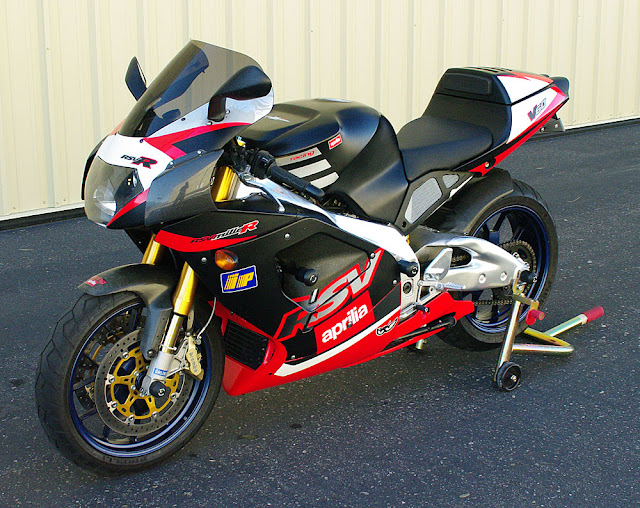Aprilia RSV Mille

The RSV's distun rive and aerodynamic shape owed much to Aprilias grand prix race bikes, and incorporated a unique triple-lens headlamp design.
the left reveals the large and highly rigid aluminium swingarni which, like the twin-spar frame, was designed with the benefit of Aprilia ’s long experience in top-level racing.
Aprilia's credentials for building a top- class superbike were impeccable. The firm from Noale in northern Italy had risen rapidly from being a small producer of lightweight bikes to become Europe’s second largest motorcycle manufacturer. Along the way, Ivano Beggio’s firm had taken on and beaten the Japanese to win a string of world titles in the ultra- competitive 250 and I25cc grand prix classes. So nobody should have been surprised by the speed and all-round ability of the RSV Mille, Aprilia’s first big four-stroke.
This was one very purposeful motorcycle. The Mille was intended as the basis for a World Superbike racer, plus a range of V-twin roadsters, and its conservative styling had its origins in Aprilia’s wind tunnel. Similarly, the alloy twin- beam frame and twin-sided swingarm were designed by race department engineers not for style, but to give maximum strength for minimum weight. The exhaust system ended in a large silencer on the right side, rather than twin pipes under the seat, because that was the lightest way of achieving the necessary volume.
There was much innovative engineering in the Mille, notably in its 998cc, dohc V-twin powerplant. After considering a Ducati-style 90- degree V-twin, Aprilia decided instead to position their engine’s liquid-cooled cylinders at 60 degrees apart, as this gave a more compact unit. A 60- degree V-twin also produces more vibration, which was cancelled by tw in balancer shafts, one in front of the crankshaft plus a smaller shaft inside the rear cylinder head.
Competitive power output
Other notable engine features were the dry sump - more compact than the normal wet sump - and the ‘power clutch’, designed to prevent the rear wheel lifting under hard braking. In other respects the fuel-injected, eight-valve V-twin engine was unexceptional. Its internal dimensions were almost identical to those of the 90-degree motors from Ducati, Honda and Suzuki. Peak power was a competitive 128bhp at 9250rpm.
The rest of the Mille was conventional but very much state-of-the-art. Suspension comprised 43mm upside-down forks from Showa of Japan, and a rear shock from Sachs. At 4161b (189kg), the Mille was slightly lighter than its Ducati rival but weighed more than the lightest of the Japanese opposition. Neat details included a high-tech instrument panel which, as well as housing a big digital speedometer, could record up to 40 lap times.
The motor was superb: strong at the top end, torquey in the mid-range and with plenty of V-twin character. Revved hard, it zipped towards the 10,000rpm limit through the excellent six-speed gearbox, a racer-style red light flickering on the dashboard to let its rider know when to change up. That top-end rush had not been achieved at the expense of power lower dow n the scale, either. The Mille responded crisply from low engine speed and simply got stronger as the revs rose, heading towards its 170mph (274km/h) top speed.
If the motor was brilliant, the RSV's chassis was just as impressive, combining high speed stability (aided by a steering damper inside the fairing nose) with light, responsive steering. Its typical super-sports geometry, rigid frame and excellent suspension resulted in a bike that could corner with the best. The only slight disappointment was a Brembo front brake that required a firm squeeze of the lever for maximum stopping power.
Some critics complained that the Aprilia lacked a little Italian glamour, but its high-quality engineering and all-round performance more than made up for that. The RSV Mille was a brilliant first effort that fully succeeded in establishing Aprilia as a major league superbike manufacturer. And which, before long, also led to a competitive World Superbike racer and a range of fast and stylish V-twins.
Aprilia surprised many people by setting its 998cc V-nvin engine’s cylinders at 60 degrees apart. The main advantage of the narrower angle was reduced length. The chief drawback, increased vibration, was addressed by twin balancer shafts.
As well as allowing the engine to be shorter, the Mille unit’s dry sump layout ensured that prolonged wheelies did not starve the motor of oil. Given the RSV’s tempting blend of instant throttle response and light weight, this was probably just as well.
Specification Aprilia RSV Mille (1998)
- Engine Liquid-cooled dohc eight-valve 60-degree V-twin
- Capacity 998cc (97 x 67.5mm)
- Maximum power 128bhp @ 9250rpm
- Transmission Six-speed, chain final drive
- Frame Aluminium twin spar
- Suspension Telescopic front; single shock rear
- Brakes Twin discs front; disc rear
- Weight 4161b (189kg)
- Top speed 170mph (274km/h)






















0 comments: